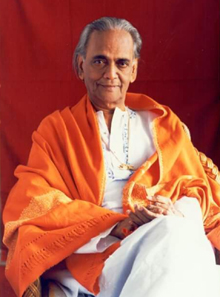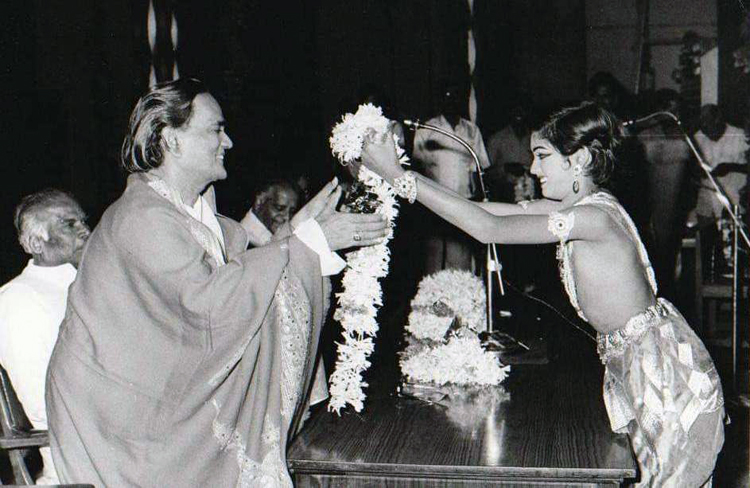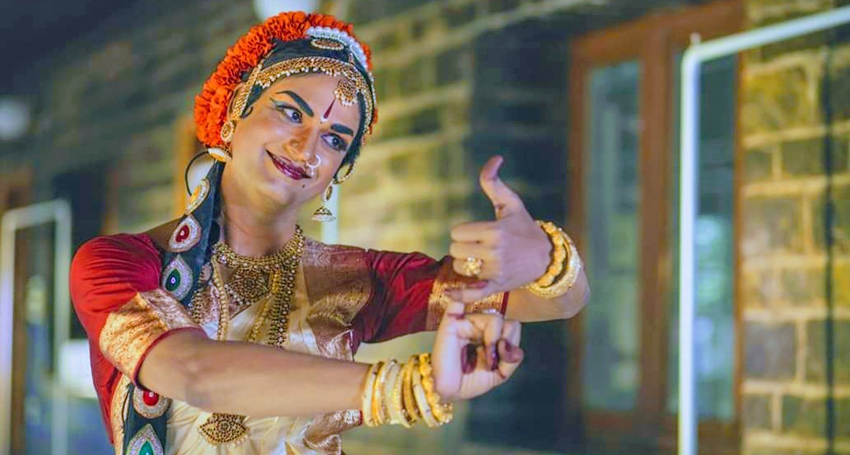Hong Kong based female impersonator Sanjay Vadapalli has been a professional dancer since the age of 16. He is a disciple of Padmashri Dr Nataraj Ramakrishna, who founded the Andhra Natyam. In an exclusive interview, Sanjay Vadapalli talks about his recent performance for Hong Kong Telugu Association, his experience with his great mentor and as to how he transforms into the female garb of the royal lady Satyabhama, the relation to Kuchipudi and Bharatanatyam and much more…
Your initiation to dance, is it hereditary or your personal choice?
SV – There is no trace of art or artists in my family in the past 7 generations. They all are highly educated and into full-time jobs (govt. and private). They were religious and spiritual but no art. When I was 5 my parents saw me copy and imitate dances that were telecasted on Doordarshan, they were surprised that l used to match the laya and talam. I also used to dance to the devotional songs played on Gramaphone and this caught the attention of my Dad. He felt that ART got transcended from my previous birth and he wanted to nourish that and encourage me. Since he didn’t have any background or contacts he spent 6 months to enquire and finally joined me under a Dance Guru at the age of 6. He used to come home to teach adavus and hand movements. I’ve learnt from him for a year and then joined Perini International to learn under the able guidance of Guru Padmashri Dr Nataraja Rama Krishna.
Did your parents encourage you?
SV – Whatever I’ve achieved as a dancer is only because of my parents. Both my mom Vijaya and Father Sivarama Krishna love arts and dance. Since I started at an early age, they supported me in every aspect of the painstaking routine from early morning wake-ups, dance practise sessions, running behind a school bus and all. It was a tough task for them to ensure I maintain a balance between art and academics and fair good in both.
They used to spend a lot of time with Guruji discussing my dance, my behaviour, diet, how to inculcate values and ensure I learn to respect the art. They had a huge role in shaping my personality and my life.
My arangetram was organized like a wedding. My parents had to shell all their savings to ensure I get opportunities to perform on stage during the early days.
Often, I joyfully recollect those episodes where my parents went with Guruji to select the right saree colour for my dress and ornaments. I clearly remember my mum standing beside my chair very closely observing every stroke of the makeup brush to ensure it all comes perfect. Constantly encouraging me backstage and also correct my abhinaya and mudras. over a period of time, my mom grasped all the repetitions and expressions so she used to correct me and it was total fun.
Even now they are very excited to attend every performance and enjoy sitting in the front row.
It’s a known truth that the art scene in India has a lot of politics, rivalry, backstabbing and sarcasm. It’s not so easy to face all this at a tender age. Even I went through a lot of politics which created hindrances. My parents have shielded and protected me from all these. They stood like a wall and suck up all the hatred, rivalry so that I can focus on dance. I still remember the amount of stress my parents went through during that time. They just didn’t let the dirty politics impact me.
When and how did you meet veteran mentor Dr Nataraj Ramakrishna?
SV – Its pure destiny and divine intervention. My first guru was a disciple of Dr Nataraja Ramakrishna. He taught me for a year and gave up due to personal commitments. After my first stint with dance took a break, my dad wanted me to learn from the Guru himself.

He got a chance to meet Guruji through a common friend. Guruji asked my dad to take me to a performance scheduled that evening. It was an impactful performance of Perini, my first time to see a male dancer. After the event, my parents were even more convinced that I should learn Perini from Guruji. But destiny has something else planned. Guruji wanted to see me before he agreed to teach. I was 8 then. After interacting with me, he was convinced that I’m very committed to dance. Considering my age, he wanted to teach me Andhra Natyam. That’s how my journey started with Guruji.
What fascinates you most about Andhra Natyam?
SV – I’m fascinated with the rich legacy of the dance form. The dance has a perfect combination of Nritta, Nritya and Abhinaya. Guruji taught us and left a great legacy of Padams and Javalis. Doing abhinaya to Padams has a soothing effect on your mind and soul. Also performing to Adhyatma Ramayana is a great feeling. Late Srimati Saride Manikyamma Garu, Sangeeta Nataka Academy awardee, used to teach abhinaya to Adhyatma Ramayana Keertanams. I’ve learnt abhinaya for entire Balakandam of Ramayana.
[adrotate group=”9″]
The prominent episode of Andhra Natyam is Nava Janardhana Parijatam. It is a variety of Kalapam (dance ballet) performed for 9 consecutive nights and on the 10th day, the valedictory function is performed consisting of the recitation of the “Dasama Skanda” (tenth canto) of Maha Bhagavatam. It is danced in the Vaishnava temples of East and West Godavari, particularly in the “Kunti Madhava” temple of Pithapuram, a former Zamindari estate.
Guruji has learnt this dance from Pendela Sathyabhama the last dancer who performed in the Kunti Madhava temple. He fine-tuned this temple dance to be performed on stage. He shortened the 9-day sequence into a 3-day stage show.
Another important part of this dance form is Perini. This is the only classical dance form in India which used to be performed by males. This dance form has its roots in Kakatiya Dynasty.
How is Andhra Natyam different from Kuchipudi and Bharatanatyam?
SV – Andhra Natyam is an ancient traditional dance form which originated as a temple dance and date back to the Buddhist era. This dance form was referred as Kaccheri, Kelika Darbaru, Mejuvani etc. and has 3 distinct styles namely: Aradhana Nrityam (temple dances) Asthana Nrityam (dance in king’s courts) and Prabandha Nrityam (dance for the common man). Dance and Abhinaya were both used for the sole performances in ancient dances.
This 3000-year-old traditional dance form has been revived and renamed as Andhra Natyam by Guru Dr. Nataraja Rama Krishna.
[adrotate group=”9″]
While Bharatnatyam predominately takes inspiration from Tanjavur style of temple dancing, Andhra Natyam has its roots in the temple tradition of Krishna, Godavari delta of Telugu region. These temple dances have a distinct style and tradition. While Kuchipudi originated as a dance ballet of Telugu region performed by male artists, Andhra Natyam is purely a solo (kacheri) aata performance mainly performed by female dancers in temples and courts of kings.
How do you feel when you disguise yourself as a woman and what has been the impact on your friends and the audience?
SV – I’ve started performing Satyabhama at the age of 11. Guruji wanted to teach me Navajanardhana Parijatam as it’s most complex composition. Also, he wanted me to carry the legacy. When I started learning this composition, I was very clear in my mind, learn, perform and carry the legacy. Guruji took lots of pain to teach me and make me understand the emotions of Satyabhama and how to depict the Nayika bhedas, abhinaya and rasas. As part of this, Guruji also taught me how to shift between personalities/ characters in a short span of time. This is very important when you are performing different characters as part of your narrative. This helped me. When on stage I depict various characters and narrate different stories and I need to transform into Satyabhama. Once I finish my performance and remove my makeup, I’m Sanjay and my personality is very different. That clarity is very important for a dancer and I learnt it pretty young.
I know we live in a world where people get tagged easily. Also, the majority thought process has been very rigid in gender definitions. But I’ve been fortunate to have great support from my family and friends. My wife, Laxmi is a great fan of my dance and has been supportive of my performances. I have a group of friends who learnt dance along with me since we were kids. They are my biggest supporters, critics and publicists. My best pal Vathsalendra Kumari is a great support for me to continue to perform Navajanardhanam.
When did you decide to become a professional dancer?
SV – At an early age only I was determined to learn and perform all through my life. There was never a time where I wanted to pursue something else. I was very clear on the purpose and strongly believe that this is a legacy I need to continue. Luckily my family, friends and colleagues have supported me in this cause.
How are you able to manage two professions. as a dancer and as a banker?
SV – It is possible when you are passionate about what you are doing. I love my job as it gave me a lot of exposure and learning. Moreover, the current job environment gives importance to work-life balance. Classical dance is all about balance, balance your adavus and coordinate with hand gestures, balance your emotions, abhinaya so that the right rasasidhi is achieved. Dance also helped me to balance my work and life. Some of the key skills to succeed in your profession like multi-tasking, out of the box thinking, coordination and teamwork, I’ve learnt all of them at an early age with Dance.
Your experience with your mentor?
SV – I’ve spent 10 years of my formative age with Guruji. He was a huge inspiration and has a great influence on my personality. He not only taught us dance but also contributed to the development of our personality, value system. We all used to spend most of the day with Guruji, learn a lot of things by observing him.

While learning dance, my day used to start at 5 am. It was a proper Guru Shishya relationship where I used to spent lot of time at the dance school. He taught me everything, starting from sitting posture, how to converse with people, how to be compassionate, dress selection depending on the event, diet restrictions. Often the afternoons were spent listening to his experiences and stories on traditions and culture.
During performances, he used to sit on the stage and keenly observe every aspect of our dance. always give the pep talk and motivate us to conquer the stage.
[adrotate group=”9″]
Travelling with him to various places is great learning. I was fortunate to spend 1 month with him in Varanasi and it was great.
Your most memorable experience?
SV – There are many. I consider performing in front of eminent Gurus as a blessing. I had the great privilege of performing in front of Pt. Birju Maharaj ji, Sitara Devi ji, Vempati Chinna Satyam ji and Kelucheran Mohapatra ji. I was fortunate to showcase my art form in front of them and seek their blessings.
In 2016 I choreographed a dance ballet on the Rivers of South India, taught to the students in the USA who mastered in Bharatnatyam and Kuchipudi and performed it on stage in the USA. It received a standing ovation and it’s a proud feeling.
When did you migrate to Hong Kong and how is the cultural scenario there, does the Government support classical artists like you?
SV – As part of my career move, I shifted to Hong Kong in 2018. It’s a great city full of energy, cosmopolitan lifestyle. There is a strong Indian presence there. Being a cosmopolitan city you get to experience different cultures and cultural events. Indians do participate in various events (govt as well as private) and showcase Indian culture. I’m closely associated with HK Telugu association THKTS. The president of the association Jaya Peesapati is a huge supporter of Indian culture and art. She always encourages me and introduces me to various events and cultural activities. Yoga has a huge demand in Hong Kong. A lot of locals join a gym to learn yoga and it’s become a livelihood for many Indians (yoga teachers).
What was the impact of your first performance in Hong Kong?
SV – It was very rewarding. UNESCO Hong Kong conducts PeaceMakers Cultural Celebrations every year and I gave my first performance in their 2019 event. We did set up a booth on Andhra Natyam. My dance was well received by both Indians living here and also the locals. The locals are very curious to understand the tradition and my interview was telecasted on local television. They have huge respect for Indian culture and traditional dance forms. Yoga is taught in every gym here. Hong Kong women are very fascinated by Indian colors, dresses and jewellery.
Your future plans or aspirations?
SV – Guru Nataraja Ramakrishna has dedicated his life for the revival of classical dance forms of Telugu speaking people, Andhra Natyam and Perini. Both are unique performing arts and carry a rich legacy. He taught the dance forms to thousands of students and always aspired to put these on the canvas of Indian classical dance forms. His dreams aren’t fulfilled yet and I want to continue his legacy. I want to continue to perform and bring well-deserved recognition and fame to these dance forms.
[adrotate group=”9″]
I want to create a library, both audio and video of Navajanardhana Parijatam, the love and hate story of Krishna and Satyabhama. Guruji has the script and songs for 9 days. These days no one is performing this dance form and I don’t want this beautiful dance tradition to perish.
I’m also planning to establish an award in the name of Guruji. The award contains a citation and cash reward and will be given to an upcoming artist who performs these dance forms. I working on the fund and will announce the details soon.










